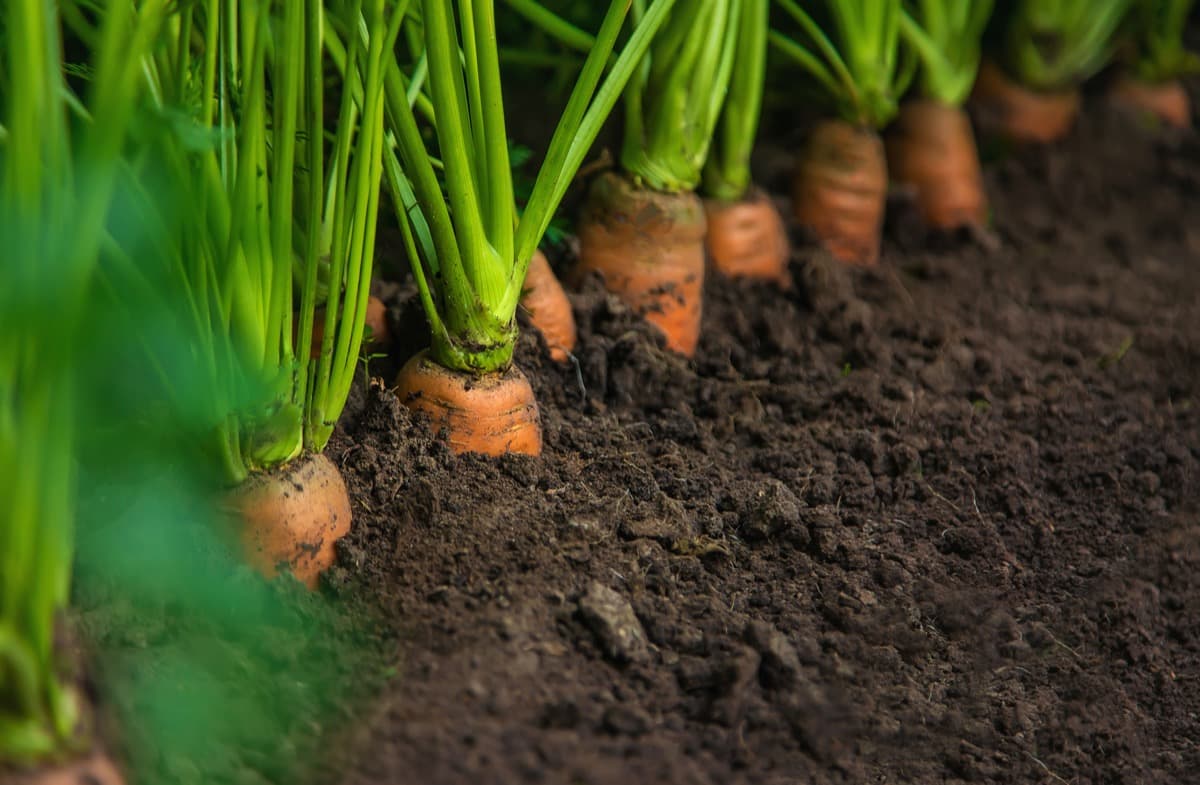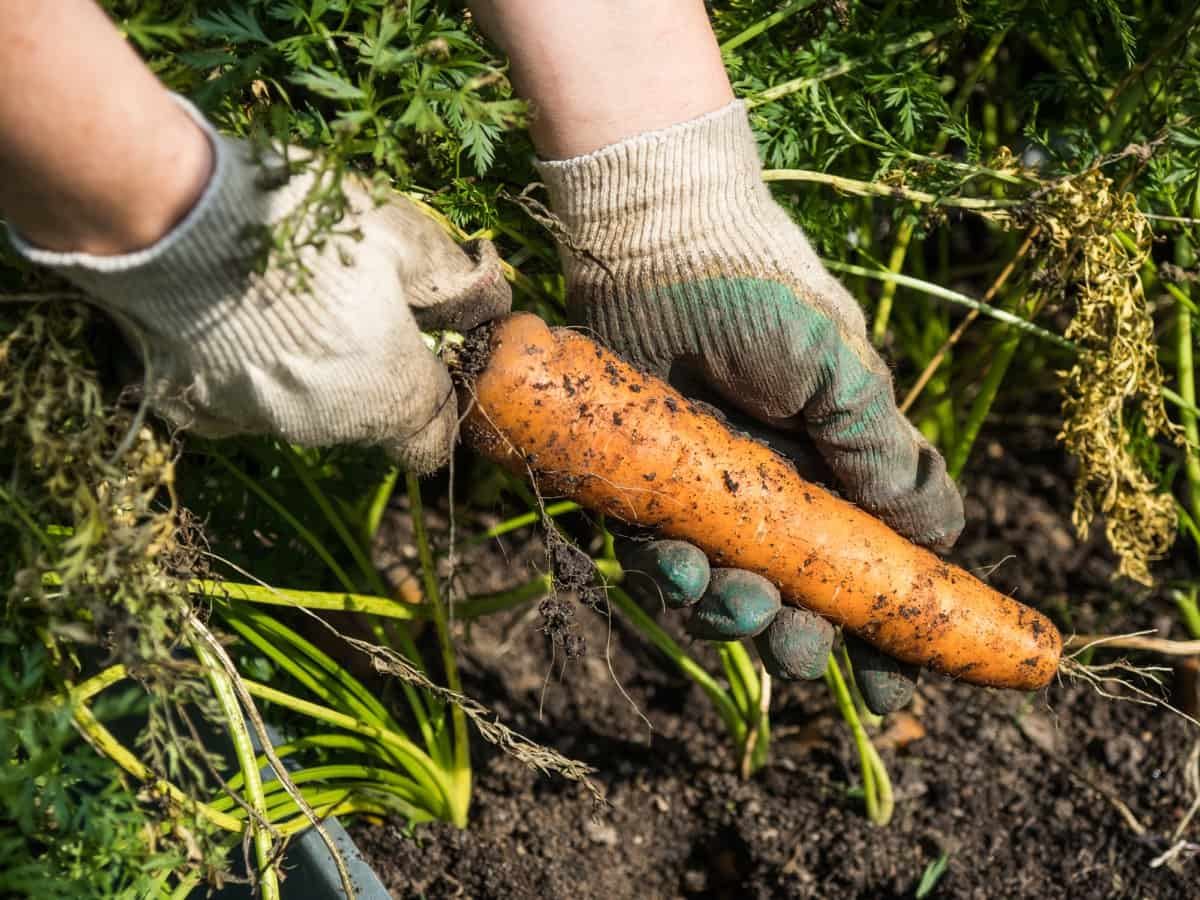Carrots. They’re among the best vegetable gardeners, but they become discouraged when they have trouble growing carrots. Carrot-growing problems are normal, and most of them can be avoided. The purpose of this article is to help you avoid or address the most common problems beginners encounter when growing carrots. With a little knowledge, you might be able to harvest more carrots than you ever thought possible.

10 Common Problems With Garden-Grown Carrot Plants
Carrot Plants With Stunted Growth
Carrots are sensitive like snowflakes, if you didn’t already know. They cannot handle extremes in any form. Carrots become stunted or small when they are exposed to excess heat. Their preferred ambient temperature ranges from 15-21°C. Over 30°C stunts their growth and causes them to have small, sad roots. Germination can also be reduced, or carrot seeds may fail to sprout in hot temperatures.
Carrots prefer full sunlight or slight shade, but excessive summer heat can damage them. Keeping carrots out of the summer is the easiest way to avoid growing them. Choose spring or fall varieties instead. If you live in a warm climate, you can choose heat-tolerant cultivars and grow carrots in more shade. And also, shade cloth can be used to reduce temperatures slightly.
Yellowing Leaves on Carrot Plants
Yellow carrot leaves indicate that something is wrong beneath the soil. Underwatering or overwatering are common causes of yellowing. Root-knot nematodes, bacterial leaf spots, root rot, or leafhoppers could cause it. If the leaves have yellow patches and brown centers or streaks on the stem, bacterial leaf spots may have taken hold. To prevent this, avoid overhead irrigation and rotate crops out of areas at least every 2-3 years.
Copper fungicides can be used to treat this. You likely have leafhoppers if you see curled, scorched, or wilted leaves. It jumps sideways around carrots and sucks juices from the leaves. This 1/3-inch-long bug is green, yellow, or brown. Neem oil or insecticidal soap can quickly eliminate them. Even better, floating row fabric can keep them away from the start.
Carrot Root Pests and Control Methods
Carrot flies: It is probably the biggest problem that home gardeners face when growing carrots that carrot flies cause. Various prevention methods include growing resistant varieties, covering the crop with fine fleece, or installing barriers at a minimum height of 75 cm around the site.
Aphids: Aphids can be controlled by squishing aphids by hand, encouraging predators such as ladybirds and hoverflies through bug hotels, and using plant oil or fatty acid sprays suitable for edible crops when a severe infestation is present.
Carrot Weevil: Carrot weevils are another common pest that can cause damage to carrot roots. They lay their eggs near carrot plants, and the larvae feed on the roots, causing wilting and stunted growth. Use insecticidal sprays or dust specifically designed to target carrot weevils.
Carrot Plants With Forked or Twisted Roots
Several factors can contribute to the development of forked or twisted roots in carrot plants. One common cause is improper soil conditions. Carrots prefer loose, well-draining soil free from rocks, clumps, or debris. If the soil is compacted or contains obstacles, such as stones or roots, the growing carrot may encounter resistance and start to fork or twist as it searches for a path of least resistance.
Another factor that can lead to forked or twisted roots is overcrowding. Carrots need ample space to grow and develop properly. When planted too close together, the roots may become tangled and deformed as they compete for resources. Following proper spacing guidelines when planting carrot seeds or seedlings is important to allow each plant enough room to grow.
In case you missed it: Common Carrot Damaging Diseases: Identification, Treatment, Management, and Control

Carrot Plant Diseases and Treatments
Carrot Black Root Rot
During the carrot’s growth, the disease can appear at any time. It isn’t limited to mature roots or roots of a certain length. As a result of root decay caused by the disease, the carrot might break when you pull it out of the ground. You would only notice the vegetable’s skin covered in black and brown splotches.
- Soak the seeds in hot water at 44-65°C if you aren’t sure they are safe. To kill the pathogens, soak the seeds for 30 minutes.
- The pH of the soil should be around 5.5.
- Every three to four years, rotate the crops.
- Get rid of infected plants and dispose of them properly.
Carrot Damping Off
During cool weather and wet soil, the fungus becomes active. The fungus attacks the roots and stems of the tender seedling, causing stress to the plant. Initially, the leaves turn brown and wilt. Under the weight of the leaves, the stems become mushy and crumble. Eventually, the plant withers and dies.
- Copper fungicides are effective against this fungus.
- Make sure the plant gets enough light and air circulation.
- For better aeration and fungus resistance, plant carrots in raised beds.
- For containers, sterilize the soil by microwaving it for 2.5 minutes before planting carrots.
Wilting Carrot Plant Leaves
Wilting carrot plant leaves can be a common concern for gardeners. Wilting carrot plant leaves can indicate various underlying issues, including insufficient watering, poor soil conditions, inadequate sunlight, pest infestation, or diseases.
By addressing these factors promptly and implementing appropriate solutions, gardeners can revive their carrot plants and enjoy healthy foliage and delicious homegrown carrots. Remember to prioritize consistent watering, maintain optimal soil conditions, provide adequate sunlight, manage pests, and monitor for diseases to ensure the health and vitality of your carrot plants.
Carrot Plant Nutrient Deficiencies
Among beginning gardeners, it’s common to believe that plants will grow better if they receive more nutrients. Lack of nutrients will likely cause development problems due to a lack of accessible potassium or phosphorus, which aids root growth. To increase phosphorus levels in your soil, you can work bone meal into it. A potassium supplement is often made from potash or wood ash.
Carrot Plants With Cracked or Split Roots
In most cases, they develop this way because the young, growing root hits a rock during growth, splitting it off. This occurs at the beginning of the carrot growing process, so it’s important to ensure the first 6 to 8 inches are loose and rock-free. Cracked roots are another thing you may experience.
You may have waited too long to harvest, which could be one reason. You may find those carrots bitter, though that’s more likely to be the case for summer-harvested carrots than for winter-harvested carrots. You could also have a dry spell followed by rain, causing them to crack.
Preventing Carrot Plants from Turning Bitter
A carrot left in the ground for too long can lose its sweetness and become bitter. It is for this reason that extra-large carrots are not recommended. A carrot’s texture changes from crisp and crunchy to touchable and woody as it ages. Despite being technically edible, they don’t taste very good. Inconsistent watering is likely the cause of bitter carrots if they are still slender and young but taste bitter. Consistency is what carrots crave most.
Carrot Plants With Green Tops but No Roots
From your planting date, calculate the days to maturity using the days to maturity listed on the seed packet. Put a reminder on your calendar when you should start pulling up a few carrots for testing. After 1-3 weeks, you should be able to pick them without them becoming oversized or bitter. Woodiness will be delayed even longer when the weather is colder, and carrots will become sweeter. Dig up all the carrots, remove their tops, wash them, and store them in a ventilated bag in the refrigerator when they reach the desired size and sweetness.
In case you missed it: How to Grow Baby Carrots at Home: A Guide to Planting to Harvest

Conclusion
In conclusion, garden-grown carrot plants can face several problems that can hinder their growth and productivity. However, by implementing the appropriate treatments and solutions, gardeners can overcome these issues and ensure healthy carrot plants with a bountiful harvest.
- Feed Your Flock for Less: Top 10 Tips to Save on Chicken Feed
- Ultimate Guide to Ossabaw Island Hog: Breeding, Raising, Diet, and Care
- Hatching Answers: The Top 10 Reasons Your Chickens Aren’t Laying Eggs
- Eggs and Economics: Breaking Down the Cost of Raising Backyard Chickens
- Defend Your Greens: Proven Methods to Keep Iguanas Out of Your Garden
- Ultimate Guide to Cinnamon Queen Chicken: A Comprehensive Guide for Beginners
- Ultimate Guide to California Tan Chicken: Breeding, Raising, Diet, Egg-Production and Care
- Ultimate Guide to Marsh Daisy Chicken: Breeding, Raising, Diet, and Care
- 10 Types of Chicken Farming Businesses You Can Start for Profits